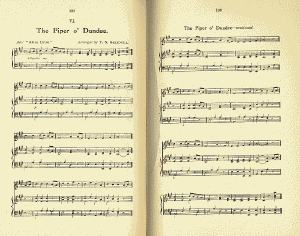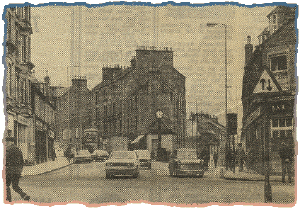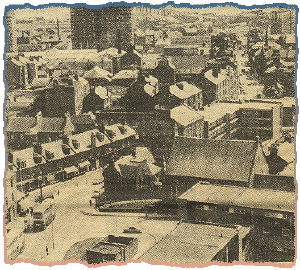|

The Piper cam’ tae oor
toon
Tae oor toon, tae oor toon,
The Piper cam’ tae oor toon,
And he play’d a bonnie lee.
He play’d a sprig, the laird to please,
A sprig brent new frae ‘yont the seas,
And then he gi’ed his bags a squeeze,
And he play’d another lee.
Chorus
And wasna’ he a rogie, a rogie, a rogie;
And wasna’ he a rogie,
The Piper o’ Dundee?
He play’d "The
Welcome o’er the Main,"
And "Ye’se be fou and I’se be fain,"
And "Auld Stuart’s back again,"
Wi’ muckle mirth and glee.
He play’d "the Kirk," he play’d "The Queen."
"The Mullin Dhu" and "Chevalier,"
And "Lang awa’ but welcome here,"
Sae sweet, sae bonnilie
It’s some gat swords, and
some gat nane,
And some were dancin’ mad their lane’;
And mony a vow o’ weir was ta’en
That nicht at Amulrie.
There was Tullibardine and Burleigh,
And Struan, Keith, and Ogilvie,
And brave Carnegie, wha but he,
The Piper o’ Dundee?
The Barronie of Hilltowne

Growing up at the Top o’ the Hill, just
beyond where Strathmartine Road begins at the Hilltown , a wee bit past
Dens Road and Kinghorne Road, above the clock at Mains Road, at the foot
of Hill Street, "The Piper o’ Dundee" was one of my favourite
songs. And as I read it now, not having sung it for many years, I realize
this piper was a rebel. A Jacobite, I’ll bet, and in his time the kind
of person I’d probably like to hang our with!
I think people at Church who know me term
me "an independent thinker." I think people at work who know me
term me a social worker who is a bit of a "cage rattler" or a
"pot stirrer," in kinder moments and maybe even a "rabble
rouser" when I’m on a tear or some kind of crusade to make my
little bit of the world into what I think is a better place. And when I
realize that my Granny’s Granny was raised by a Highland (Stanley and
Errol in Perthshire) mother who was born not so long after the great
rebellions of the 18th Century – the French and American Revolutions and
the ’15 and the ’45 Rebellions – I understand why "The
Piper" would leave such an impact on a wee lass in the 1950’s.
Strathmartine Road stretches from the
Hilltown all the way out to Downfield. There’s many a time my mother and
I would hike out to Baldovan, (where the Borstal or "bad boys
school" was) often with Laddie the collie, then down past the farms
to, sorry, folks, here it comes, I can’t not say it, Bammie Doon, where
the mental hospital was, and then back up to catch the Number 20 bus home.
Other times we’d take the 22 out to the terminus, then hike on down to
the Sidlaws, basically tracing the steps of Martin chasing the dragon down
the Strath. (That story my granny gave me I’m going to tell in
"Tales and Legends" – and you can’t skip on ahead if you’re
one of my installment readers on the Web at electricscotland.com, because
I haven’t got to that section yet – even though the raw materials, and
the pictures, and the memory prompters are all there waiting in
"Section 12": this is Section 6, so we’ve got a wee bittie to
go.)
The Hilltown began as just that, Hill Town.
According to the Reverend William Cumming Skinner, of Hilltown United Free
Church, in his history written in 1927, Hilltown was a Barony and Dundee
was the City, which later took the Hilltown into its governance. Skinner
writes "’The Hilltown of Dudhope’– called the Rotten Row –
was first created into a ‘Burgh of Barony’ by a charter from Charles
I, in favour of Sir James Scrymseoure, the twelfth Constable of Dundee,
and second Viscount Dudhope. It is dated the 4th September 1643."

I spent many happy hours playing down at
Dudhope Castle. Of course, in my time it was nothing like the illustration
above, but it still stood firmly in the park. Not too far away from the
castle was a children’s playground – with swings, a chute, (or slide),
a maypole, and a merry go round that we’d try to get to go as fast as it
could round and round and round by running and pushing and jumping on and
enjoying the ride, holding on for dear life, and rejoicing that you weren’t
one of the unfortunates who fell off and landed on the hard ground! (Yes,
indeed, I was a wee terror!)
And, believe it or not, somehow or other I
once got inside the castle – can’t remember if I paid for part of a
tour, or just sneaked or charmed my way in – and got to see the
"Spiked Maiden." I have no idea where I managed to get the
Reverend Skinner’s great 1927 book of the Hilltown and Dundee. I’m
just grateful I grabbed it to hold on to and be able to share Dundee with
my family. He has a much better description of the Maiden than I could
ever give you:
…The public hanging on the Cragies
Gallows belonged to milder days than those represented by the "Nurenburgh
Maiden" exhibited in the museum at Dudhope Castle. It came there from
a collection formed by a Mr Lumsden, who lived somewhere in Fife, and may
possibly have returned to its primal home after many days of wandering. It
is of iron and formed like an Amazon Maiden, into whose bosom you go to be
pierced through and through with iron spikes. Whether she rolled herself
down the hill with her victim enclosed we do not know, but that game would
only be on a line with what was common practice in the torture of
criminals in other parts."
James V. may have seen it when he visited
the Fortalice about 1540, and afterwards crossed to Skye to visit the
""Macdonald of the Isles" at Duntulm Castle. There he would
be shown the "three Cnocs" –the Hill of Judgment or Pleas, the
Hill of Counsel, and the Hill of Hanging. In the old days there, as
elsewhere, it was on such Cnocs that the Chief sat in state, dispensing
advice, justice, and punishment. There, clad in his Coat-of-Mail, or
Luireach, with conical helmet, bearing the three eagle’s plumes and
badge of his clan, the Chief was enthroned, his right hand resting on the
pommel of his Claymore, thrust upright into the ground beside him. There,
occupying the Hill proper to the specific matter in hand, he meted out
stern justice as he sat – a terrible figure of inviolable majesty, well
calculated to strike awe into the hearts of the clansmen. James was no
doubt also shown the "Barrel Hill," and possibly given a
demonstration of its effectiveness in torture. Inveterate criminals
generally suffered torture before that death came to their relief, and the
common saying that "hanging is too good for him" is just a relic
of our ancestors’ way of thinking – and acting. The victim was
enclosed in an iron barrel studded with spikes pointing inwards. The side
of the barrel opened like a door to receive its guest. When closed the
spikes passed through he body of the victim. The barrel was then rolled
down the Hill of Hanging, and the sequel can be easily imagined."
Skinner’s book has more than just torture
and hangings in it. There’s a great chapter on wedding and birth
customs, and wonderful historical details about the role of religion and
free trade in the development of the Hilltown, along with chapters on
industry, education and folk lore, some of which I might add in to future
chapters of this Scrapbook.

The Hilltown, dated about 1905, published in a 1977 edition of the
Courier.
This picture of the top of the Hill, with
the Hilltown Clock in the center towards the back, and the pub in the left
foreground, looks just like I remember our part of town as I was growing
up. I remember people as friendly, helpful in the shops, and I felt safe
running up and down Hill Street, going across the street to help groom the
Clydesdales in the big pend where they were stabled; crossing the road
right where those tram lines are to go to the meal man for dog food for
Rex, our Airedale, or to get other messages for my mother or Granny. This
is really where my character was formed, on listening to stories from my
Granny or being reminded to "take a telling" from neighbours as
well as family and teachers when I went just a wee bit too far in my
adventuring.
My daughter, Tina, gave me a book with
poems, and quotations and stories that, if you read it carefully, gives
wonderful background and descriptions of Scotland and her people. It’s
not quite a "wha’s like us, damn few and they’re a’ deid"
kind of book, but the contents certainly stir my blood and confirm to me
that to be a Scot is to be one of God’s chosen. Here’s a few extracts
from Scotland, An Anthology, by Douglas Dunn.
Plurals
Behind all this is the peculiarity of the Scottish character, and
there is probably more whigmaleerie written about that than about anything
else. Scots are supposed to be dour, canny, pawky, coarse, fly, stingy,
pedantic, moralistic, and drunken all at once, combining the severity of
Calvin with the lasciviousness of Burns. They are characterized as a
mixture of the legendary Sawney Bean, the grotesque Galloway rogue who
consumed human corpses and lived in a cave, and David Livingstone (an
ancestor of mine), who darned his won frock coat neatly in the African
jungle. They are, as the saying goes, like dung – no good unless spread
– and there is no doubt that Scots do get spread to a quite amazing
degree over the face of the earth. There has always been a drift away from
the stoney barrenness of the home ground out into the expansive world, yet
for wandering Scots the homeland never quite disappears. The odd thing is
that almost everything said about the Scots is true, but never the whole
truth – their character has so many sides to it.
Alastair Reid, The New Yorker (1964).
John Buchan at a Lectern
We will take the prosaic side first. We Scotsmen are a commonplace
folk, fond of sticking close to the ground, and asking a reason for things
and a practical justification. We take a pleasure, a malicious pleasure, I
am afraid, in pricking bubbles; and though we are very sentimental
ourselves, we like to pour cold water on other people’s sentiment...
…Now I want you to turn to the other side
of the Scottish character, the side which is as far distant as possible
from the cautious, prosaic, worldly-wise side. I have been talking about.
With all our prudence, our history is a record of the pursuit of lost
causes, unattainable ideals, and impossible loyalties. Look at the long
wars of independence which we fought under Bruce and Wallace. If we had
had any sommon sense we would have made peace at the beginning, accepted
the English terms, and grown prosperous at the expense of our rich
neighbours. Look at the wars of religion, when for a refinement of dogma
and a nice point of Church government the best of the Lowland peasantry
took to the hills. Look at the Jacobite risings. What earthly sense was in
them? Merely because Prince Charlie was a Stewart, and because he was
young and gallant, we find sober, middle-aged men, lairds, lawyers, and
merchants, risking their necks and their fortunes to help a cause, which
was doomed from the start. We have, all of us, we Scots, a queer daftness
in our blood. We may be trusted to be prudent and sensible beyond the
average up to a certain point. But there comes a moment when some
half-forgotten loyalty is wakened, and then we fling prudence to the
winds. The truth is that we are at bottom the most sentimental and
emotional people on earth. We hide it deep down, and we don a mask of
gravity and dour caution, but it is there all the time, and all the
stronger because we hide it so deep.
John Buchan, "Some Scottish
Characteristics’ in W. A. Craigie et. Al., The Scottish Tongue (1924).
We lived around Strathmartine Road for
generations. According to birth, marriage and death certificates and
Census records I’ve been able to find, the McIntoshes and Beats and
Benvies and Morrisons lived in Bucklemackers Wynd, Wellingtron Street and
Hospital Park as well as Hill Street and on the Hilltown Road itself. The
Forbes lived at the Downfield end of Strathmartine Road and my Granny’s
granny, Jessie Hackett Beat, took her to St Salvador’s Church. Jessie
and her daughter, Auntie Chat (Charlotte) had a pottery shop and a
fishmonger on Kinghorne Road. And even though our home in Hill Street was
torn down to build multi-stories and we were moved to St Mary’s when I
was about 15 or 16, and enjoyed having electric light instead of gas
mantles, and lots of hot water and a bath in its own room and not a zinc
tub we brought in from the lobby and filled up in front of our kitchen
fire, I’ll always think of myself not only as a Dundee lass, but as a
Hilltown girl.

Another Courier picture, the Hilltown
in my time. And there’s the Clock, and the pub, and the road to the meal
man and the Number 20 bus heading to the City Center.
I get sentimental when I play "The Miles to Dundee" and think
of the "howe of Strathmartine" being behind me in that childhood
sense. I think of hiking up Hill Street to the top of the Law or down the
Hill to the Wellgate and town, the busses I caught and the ones I missed,
the frequent rain and the warm summer sunshine and the snow that too
quickly turned into slush on those steep braes that lead and encircle the
Hilltown, and most of all, "my ain folk" of shopkeepers and
neighbours and schoolfriends and my ancestors who were all part of my
growing years. And I wish I could go back in time like a character from
Wells’ "The Time Machine" or Diana Gabaldon’s
"Outlander" novels or TV shows like "Sliders" or
movies like "Somewhere in Time" and spend a few hours there once
again before returning to my family of seven children and the ever growing
number of grandchildren they’re bringing in to my life here in America.
But that can’t be done. So, I read books and make this scrapbook, and
write my stories, and seek out my ancestors possibly because, according to
Robert Louis Stevenson, "For that is the mark of the Scot of all
classes: that he stands in an attitude towards the past unthinkable to
Englishmen, and remembers and cherishes the memory of his forebears, good
or bad; and there burns alive in him a sense of identity with the dead
even to the twentieth generation." (Weir of Hermiston, 1896).
And now we come to the modern Hilltown, and
the view from a multi story built probably on the land I played around at
the bottom of Hill Street –

And there’s the Number 20 headed doon
the toon.
And there’s the Church where I was christened.
And there’s the clock that I could see from our bedroom window.
And there’s the Hilltown brae and the Tay Brig off in the distance.

And isna’ she a rogie,
a rogie, a rogie;
And isna’ she a rogie,
The Wee Lassie frae Dundee?
|

